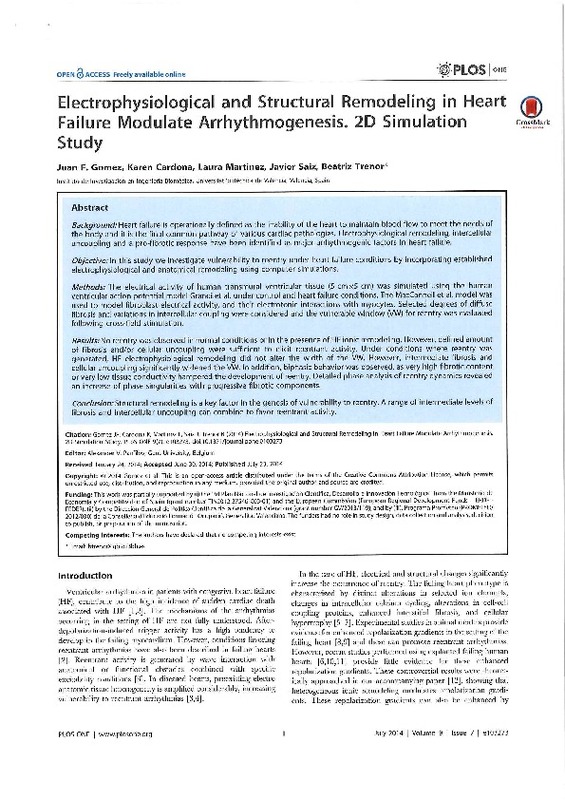JavaScript is disabled for your browser. Some features of this site may not work without it.
Buscar en RiuNet
Listar
Mi cuenta
Estadísticas
Ayuda RiuNet
Admin. UPV
Electrophysiological and Structural Remodeling in Heart Failure Modulate Arrhythmogenesis. 2D Simulation Study
Mostrar el registro sencillo del ítem
Ficheros en el ítem
| dc.contributor.author | Gómez García, Juan Francisco
|
es_ES |
| dc.contributor.author | Cardona, Karen
|
es_ES |
| dc.contributor.author | Martínez, Laura
|
es_ES |
| dc.contributor.author | Saiz Rodríguez, Francisco Javier
|
|
| dc.contributor.author | Trénor Gomis, Beatriz Ana
|
|
| dc.date.accessioned | 2015-07-08T12:00:31Z | |
| dc.date.available | 2015-07-08T12:00:31Z | |
| dc.date.issued | 2014-07-23 | |
| dc.identifier.issn | 1932-6203 | |
| dc.identifier.uri | http://hdl.handle.net/10251/52833 | |
| dc.description.abstract | Background: Heart failure is operationally defined as the inability of the heart to maintain blood flow to meet the needs of the body and it is the final common pathway of various cardiac pathologies. Electrophysiological remodeling, intercellular uncoupling and a pro-fibrotic response have been identified as major arrhythmogenic factors in heart failure. Objective: In this study we investigate vulnerability to reentry under heart failure conditions by incorporating established electrophysiological and anatomical remodeling using computer simulations. Methods: The electrical activity of human transmural ventricular tissue (5 cm65 cm) was simulated using the human ventricular action potential model Grandi et al. under control and heart failure conditions. The MacCannell et al. model was used to model fibroblast electrical activity, and their electrotonic interactions with myocytes. Selected degrees of diffuse fibrosis and variations in intercellular coupling were considered and the vulnerable window (VW) for reentry was evaluated following cross-field stimulation. Results: No reentry was observed in normal conditions or in the presence of HF ionic remodeling. However, defined amount of fibrosis and/or cellular uncoupling were sufficient to elicit reentrant activity. Under conditions where reentry was generated, HF electrophysiological remodeling did not alter the width of the VW. However, intermediate fibrosis and cellular uncoupling significantly widened the VW. In addition, biphasic behavior was observed, as very high fibrotic content or very low tissue conductivity hampered the development of reentry. Detailed phase analysis of reentry dynamics revealed an increase of phase singularities with progressive fibrotic components. Conclusion: Structural remodeling is a key factor in the genesis of vulnerability to reentry. A range of intermediate levels of fibrosis and intercellular uncoupling can combine to favor reentrant activity. | es_ES |
| dc.description.sponsorship | This work was partially supported by (i) the "VI Plan Nacional de Investigacio n Cientifica, Desarrollo e Innovacion Tecnologica'' from the Ministerio de Economia y Competitividad of Spain (grant number TIN2012-37546-C03-01) and the European Commission (European Regional Development Funds -ERDF FEDER), (ii) by the Direccion General de Politica Cientifica de la Generalitat Valenciana (grant number GV/2013/119), and by (iii), Programa Prometeo (PROMETEO/ 2012/030) de la Conselleria d'Educacio ' Formacio I Ocupacio, Generalitat Valenciana. The funders had no role in study design, data collection and analysis, decision to publish, or preparation of the manuscript. | en_EN |
| dc.language | Inglés | es_ES |
| dc.publisher | Public Library of Science | es_ES |
| dc.relation.ispartof | PLoS ONE | es_ES |
| dc.rights | Reconocimiento (by) | es_ES |
| dc.subject | Computer modelling | es_ES |
| dc.subject | Electrophysiological and Structural Remodeling | es_ES |
| dc.subject | Heart Failure | es_ES |
| dc.subject.classification | TECNOLOGIA ELECTRONICA | es_ES |
| dc.title | Electrophysiological and Structural Remodeling in Heart Failure Modulate Arrhythmogenesis. 2D Simulation Study | es_ES |
| dc.type | Artículo | es_ES |
| dc.identifier.doi | 10.1371/journal.pone.0103273 | |
| dc.relation.projectID | info:eu-repo/grantAgreement/MINECO//TIN2012-37546-C03-01/ES/CORAZON HUMANO COMPLETO FISIOLOGICO VIRTUAL: MEJORAS EN EL TRATAMIENTO DE ARRITMIAS CARDIACAS ORIENTADO A PACIENTE/ | es_ES |
| dc.relation.projectID | info:eu-repo/grantAgreement/GVA//GV%2F2013%2F119/ | es_ES |
| dc.relation.projectID | info:eu-repo/grantAgreement/GVA//PROMETEO%2F2012%2F030/ES/MEJORA EN LA PREVENCION Y TRATAMIENTO DE PATOLOGIAS CARDIACAS A TRAVES DE LA MODELIZACION MULTI-ESCALA Y LA SIMULACION COMPUTACIONAL (DIGITAL HEART)/ | es_ES |
| dc.rights.accessRights | Abierto | es_ES |
| dc.contributor.affiliation | Universitat Politècnica de València. Instituto Interuniversitario de Investigación en Bioingeniería y Tecnología Orientada al Ser Humano - Institut Interuniversitari d'Investigació en Bioenginyeria i Tecnologia Orientada a l'Ésser Humà | es_ES |
| dc.contributor.affiliation | Universitat Politècnica de València. Departamento de Ingeniería Electrónica - Departament d'Enginyeria Electrònica | es_ES |
| dc.description.bibliographicCitation | Gómez García, JF.; Cardona, K.; Martínez, L.; Saiz Rodríguez, FJ.; Trénor Gomis, BA. (2014). Electrophysiological and Structural Remodeling in Heart Failure Modulate Arrhythmogenesis. 2D Simulation Study. PLoS ONE. 9(7). https://doi.org/10.1371/journal.pone.0103273 | es_ES |
| dc.description.accrualMethod | S | es_ES |
| dc.relation.publisherversion | http://dx.doi.org/10.1371/journal.pone.0103273 | es_ES |
| dc.type.version | info:eu-repo/semantics/publishedVersion | es_ES |
| dc.description.volume | 9 | es_ES |
| dc.description.issue | 7 | es_ES |
| dc.relation.senia | 276140 | |
| dc.identifier.eissn | 1932-6203 | |
| dc.identifier.pmid | 25054335 | en_EN |
| dc.identifier.pmcid | PMC4108391 | en_EN |
| dc.contributor.funder | Generalitat Valenciana | es_ES |
| dc.contributor.funder | Ministerio de Economía y Competitividad | es_ES |
| dc.contributor.funder | European Regional Development Fund | es_ES |








